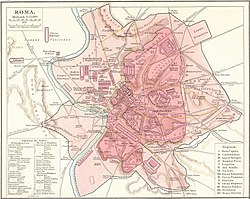Temple of Juno Moneta
| Location | Regione VIII Forum Romanum |
|---|---|
| Built in | 344 BC |
| Built by/for | Lucius Furius Camillus |
| Type of structure | Temple |
| Related | Capitoline Hill |
The Temple of Juno Moneta (Latin: Templum Iunonis Monetæ) was an ancient Roman temple that stood on the Arx or the citadel on the Capitoline Hill overlooking the Roman Forum. Located at the center of the city of Rome, it was the place where Roman coins were first minted, thereby initiating the ancient practice of associating mints with temples. In addition, it was the place where the books of the magistrates were deposited.
Juno Moneta, the second name associating the Roman goddess Juno with the goddess Moneta who was worshipped at some locations outside Rome, was regarded as the protectress of the city's funds. Money was coined in her temple for over four centuries, before the mint being moved to a new location near the Colosseum during the reign of emperor Domitian. Thus, moneta came to mean "mint" in Latin, which was used in written works of ancient Roman writers such as Ovid, Martial, Juvenal, and Cicero, and was the origin of the English words "monetary" and "money".
Cicero suggests that the name Moneta derived from the verb "monere", because during an earthquake, a voice from this temple had demanded the expiatory sacrifice of a pregnant sow, connecting to the old Roman legend that Juno's sacred geese warned the Roman commander Marcus Manlius Capitolinus of the approach of the Gauls in 390 BC. But modern scholars reject this explanation.
Moneta is also a name used for Mnemosyne, mother of the Muses, by Livius Andronicus in his translation of the Odyssey, and Hyginus' citation of Jupiter and Moneta as parents of the muses. The name Mnemosyne or Memory was connected to Juno Moneta who maintained in her temple an unimpeachable record of historical events.
...
Wikipedia

